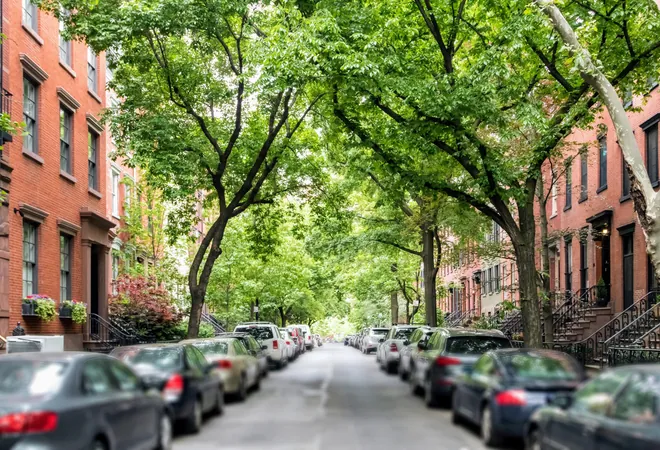
The Hidden Health Benefits of Urban Tree Layout: Could Your Life Depend on It?
2025-03-21
Author: Jia
The Hidden Health Benefits of Urban Tree Layout: Could Your Life Depend on It?
Trees and parks are more than just scenic additions to our cities—they play a crucial role in enhancing human health. From filtering out harmful air pollutants to providing essential shade during scorching urban summers, greenery serves as a natural ally for urban dwellers.
In response to climate change and rising temperatures, governments worldwide are rallying around ambitious tree-planting initiatives. However, a significant challenge persists: finding enough space for new green areas amidst the concrete jungles of heavily populated cities.
The pivotal question arises: How can city leaders optimally design existing green spaces to maximize their health benefits for residents?
Linking Urban Greenness and Health
Recently, researchers at ETH Zurich have delved into this pressing issue, expanding their research not just within Switzerland, but also taking insights from urban areas in Asia. The Future Cities Lab, which operates in Singapore under the umbrella of ETH Zurich and the National University of Singapore (NUS), has unearthed remarkable links between tree management in cities and the overall health of their inhabitants.
The research team conducted a comprehensive analysis using high-resolution data within a 500-meter radius of individuals' homes. They meticulously examined factors such as tree canopy coverage, the proximity of tree clusters, their interconnections, and their shapes to establish a nexus between urban forestry and health outcomes.
Using mortality data from over six million adults, courtesy of the Swiss Federal Statistical Office (covering the decade from 2010 to 2019), the researchers maintained individual privacy while drawing significant correlations.
Mortality Rates and Tree Canopy Coverage
The findings from this meticulous analysis revealed a striking association: neighborhoods with expansive, cohesive tree canopies were linked to lower mortality rates. Residents in areas characterized by larger and better-connected tree clusters lived longer compared to those residing in neighborhoods where tree coverage was fragmented and irregularly shaped.
This relationship was especially pronounced in densely populated urban and peri-urban settings known for poor air quality and heightened temperatures. Here, properly organized green spaces proved to offer health benefits that could outweigh those in more dispersed environments.
While these results provide fascinating insights, the researchers, including Dengkai Chi, the study's lead author, caution against establishing direct causation just yet. "Data shows clear correlations, but we still haven’t defined a direct causal link. It's imperative to consider factors like age, gender, and socio-economic status while analyzing these results," Chi explained.
The Importance of Connectivity in Green Spaces
The crux of the research emphasizes thoughtful arrangement of urban trees. By strategically planning green areas, city officials can potentially unlock greater health advantages for residents. "To fully leverage the health benefits of trees, cities should aim to not only plant more trees but also to link isolated green patches together—such as by creating tree-lined boulevards," Chi suggested.
Interestingly, the study also indicated that simpler arrangements—like circular or rectangular tree patches—may foster better health outcomes than more complex designs. These straightforward geometrical shapes can lead to central areas that enhance ecological diversity, encouraging public engagement with green spaces.
Future Directions in Urban Greening
Nevertheless, the research team acknowledges the journey ahead. Important variables such as pre-existing health conditions, lifestyle choices like smoking, and actual park utilization couldn't be analyzed, and results at a larger city scale remain inconclusive.
Initial findings imply that health benefits could correlate not only with the presence of green spaces but also with their equitable distribution, ensuring a majority of the population can easily access them.
As they continue their exploration, the team aims to refine quantitative assessments and establish clear thresholds that could inform actionable guidelines for urban greening efforts.
Overall, the study serves as a vital reminder that urban greenery contributes not only to the aesthetic appeal of cities but also plays an integral role in affecting public health. In an era of climate change and increasing urbanization, the strategic design and placement of tree canopies may be as important as the act of planting them.
The insights from this critical research have been published in the esteemed journal Lancet Planetary Health, promising to reshape urban planning paradigms moving forward.
Stay tuned for more updates on how urban design can influence your life!


 Brasil (PT)
Brasil (PT)
 Canada (EN)
Canada (EN)
 Chile (ES)
Chile (ES)
 Česko (CS)
Česko (CS)
 대한민국 (KO)
대한민국 (KO)
 España (ES)
España (ES)
 France (FR)
France (FR)
 Hong Kong (EN)
Hong Kong (EN)
 Italia (IT)
Italia (IT)
 日本 (JA)
日本 (JA)
 Magyarország (HU)
Magyarország (HU)
 Norge (NO)
Norge (NO)
 Polska (PL)
Polska (PL)
 Schweiz (DE)
Schweiz (DE)
 Singapore (EN)
Singapore (EN)
 Sverige (SV)
Sverige (SV)
 Suomi (FI)
Suomi (FI)
 Türkiye (TR)
Türkiye (TR)
 الإمارات العربية المتحدة (AR)
الإمارات العربية المتحدة (AR)